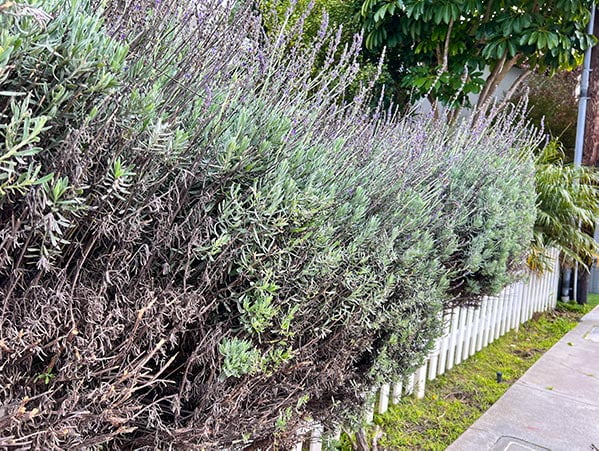The lavender tree is an incredible plant that is not only aesthetically pleasing, but it smells heavenly. The leaves are aromatic, and the flowers are beautiful. It can be used for medicines, distilled into essential oils, and even eaten! And care for a lavender plant couldn't be easier, as it actually prefers harsh conditions! But - did you know that you can grow lavender in tree form? Imagine a topiary tree with purple flowers and a strong perfume of lavender! Below, we'll tell you everything you need to know to grow a lavender tree.
What Is A Lavender Tree?
Hold on a minute. Isn't lavender a type of flower? Well, yes - lavender is a flowering shrub from the Mediterranean region. Highly aromatic leaves and purple flower spikes grow on woody stems as part of a rounded shrub. However, like all shrubs, lavender plants can be trained to grow in a tree shape - like a lavender topiary.
There are many different types of lavender, but Spanish lavender is the variety typically used in growing lavender trees. Lavender trees will grow between 2 and 3 feet tall, and the bushy crown will be 2 feet wide.
While you can purchase an already-potted lavender tree, the easier way to grow it is to start with a regular lavender plant from a nursery or greenhouse and prune the stems as it grows into the shape you desire.
Lavender Tree Care Requirements
Light
For lavender topiaries with beautiful purple flowers, you need to place your plant where it can receive full sunlight daily. Otherwise, your plant will grow spindly.
A lavender tree needs a bare minimum of 6 hours of sun each day, and the longer it's exposed to the sun, the better. Ample sunlight is important for any lavender plant, but it's especially important for lavender trees, which have fewer leaves than lavender shrubs. If you are growing your lavender tree indoors, place it in the sunniest spot available.
Water
It's important not to overwater your lavender tree. Plant your lavender tree in a pot with drainage holes, use well-drained soil, and only water it when the top inch of the soil feels dry to the touch.
Overwatering lavender trees cause them to droop and lead to root rot. If a lavender tree gets too little water, it will stun your tree's growth.
Temperature
Lavender trees like warm temperatures. Some types of lavender, such as English lavender, are hardy and can handle cold temperatures, but this lavender variety is not often used to make lavender trees. French lavender, Portuguese lavender, and Spanish lavender require a hot climate.
If you live in USDA Hardiness Zone 6 or below, you'll need to grow your small lavender tree in a pot and take it indoors once the daytime temperature drops below 60 degrees Fahrenheit. If you live in Zones 7 to 10, your lavender topiary can be planted directly in the ground. In these zones, the tree can survive winter outdoors.
Humidity
All lavender varieties are native to warm, arid climates. It's important to keep the humidity level around your plant low, and Ideally, this should be around 40% humidity.
Soil
A potted lavender plant needs well-draining soil, since potted plants tend to hold on to moisture longer than plants placed in a garden.
Start with slightly alkaline soil, and amend it by adding perlite and gravel. You can create alkaline soil by adding a spoonful of garden line to neutral soil. The soil can be moderately fertile, but your lavender tree will grow best in lean, somewhat rocky soils.
Fertilization
With enough sunlight and appropriate watering, your lavender tree will not need fertilizing. However, you can give it a boost. Apply a diluted slow-release fertilizer in early spring and late fall right after pruning. Do not apply too much fertilizer, as this will encourage the tree to put out fewer flowers and more leaves. To play it safe, avoid fertilizing at all.
Pruning
As your first train your lavender plant into a tree shape, you'll need to prune away the plant's lower side shoots and stems. The central stem should be left, along with the bushy growth at the top. Initially, this will leave the lavender plant rather weak, so support it with a bamboo cane.
Once established, lavender tree pruning will need to occur twice yearly. The early spring pruning will be your "shaping" pruning and will promote healthy growth throughout the season. Cut away any stems that are growing too low or are starting to grow downwards. Eventually, the bare wooden stem of your lavender tree will stop putting out new branches and concentrate its energy on the flowering top.
In the autumn, prune the top of the tree for its winter dormancy. Cut each flower stalk down so that 2 to 3 inches of green growth remain. This pruning may seem severe, but cutting the flowers back this far will encourage bushy growth the following year.
If you fail to prune your lavenders properly, they will look woody and spindly with dead flowers.

Common Problems With Lavender Trees
Fungal diseases are a concern with lavender flowers. It's important to provide plenty of air circulation if growing a lavender tree indoors and to allow proper spacing between plants if your lavender tree is in an outdoor space. Too much moisture - both in the soil and in the air - will kill a lavender tree.
Are Lavender Trees Pet Friendly?
Lavender contains a small amount of linalool. This substance is toxic to dogs and cats, but linalool is found in such small amounts in a lavender plant that it's not considered toxic to pets.

